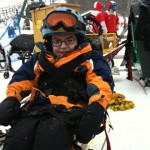Access is a human right. Access is also a bipartisan issue, and our family will forever be grateful for the pioneering work of Presidents Ronald Reagan and George H.W. Bush and Senators Bob Dole, Tom Harkin and Teddy Kennedy for their work in passing the ground-breaking Americans with Disabilities Act in 1990. Yes–it’s hard to believe, but this law is only approaching its 22nd birthday.
The ADA, along with the Individuals with Disabilities Education Act (IDEA), make Ben’s life, and the lives of millions of other children, accessible. IDEA governs how states and public agencies provide early intervention, special education and related services to more than 6.5 million eligible infants, toddlers, children and youth with disabilities. And let’s not forget Section 504 of the U.S. Rehabilition Act, which opens the door to many others who don’t qualify for educational services under IDEA but who have access and information technology needs, or the many workers with disabilities who need accommodations in their workplaces in order to work productively and on the same playing field as their peers.
It’s hard to imagine how inaccessible life was before ADA, IDEA and Section 504. What could be more important to a person with mobility, visual, hearing, medical or learning challenges? Imagine being at a school where you couldn’t access a classroom because of stairs, or you couldn’t take part in a classroom because you couldn’t see the blackboard or slides, hear your teacher talk, lift or carry your books or write with a pencil on paper. Your brain would be telling you that you understand all the material and can do all of the lessons, but your body is not cooperating with your brain. It’s a constant internal struggle–with few external supports.
Even now, there are still access issues in the community–often we want to go out to dinner as a family but even a 2 inch threshhold in the restaurant’s doorway is enough to prevent Ben’s power wheelchair from accessing the building. Ben would love to see a movie with his sisters or friends, but the noise is overbearing, or his eyes are unable to process the 3D special effects. Ben can often get lost in the crowds because the types of markers he usually uses to help him navigate his enviroment aren’t accessible to him because he can’t see over people’s heads, around their bodies, or possibly because it is dark. In the confusion, he sometimes can’t differentiate between right and left.
President Barack Obama reflected all of this when commemorating the ADA’s 20th anniversary on July 26, 2010:
Today, as we commemorate what the ADA accomplished, we celebrate who the ADA was all about. It was about the young girl in Washington State who just wanted to see a movie at her hometown theater, but was turned away because she had cerebral palsy; or the young man in Indiana who showed up at a worksite, able to do the work, excited for the opportunity, but was turned away and called a cripple because of a minor disability he had already trained himself to work with; or the student in California who was eager and able to attend the college of his dreams, and refused to let the iron grip of polio keep him from the classroom — each of whom became integral to this cause.
But there is so much hope! For years, Ben has been working with an Orientation and Mobility specialist–sometimes from Perkins School for the Blind, sometimes from the Carroll School for the Blind–who teaches him the special cues he needs to follow so that he doesn’t fall off the edge of a sidewalk, doesn’t underestimate the closeness of a stair landing, who teaches him how to remain calm in a crowded and dark setting. The O&M specialist, the Teacher of the Visually Impaired who teaches Ben Braille, the school assistive technology specialist, all work with Ben, his teaching assistant, his teacher, and the school to make sure that as much of Ben’s enviroment is barrier-free–yellow stips are placed near all stair landings and stairs and on all curbs; that signs are placed at his eye level in addition to the eye level of other students; that he gets time to access hallways enroute to the cafeteria, library, music and art rooms before they become mobbed with other kids. Ben has also been allowed to arrive at school earlier in the day and get settled before the rest of the school enters, and he leaves his classroom 5 minutes earlier, in order to get to his wheelchair-accessible bus before the rest of the school streams out at dismissal. Every one of these accommodations make life accessible for Ben.
There are some places, institutions, and people who go above and beyond federal regulations to make life accessible and barrier-free for Ben and others. It’s on this page that I’ll highlight these achievements, our experiences, and “shout out” to those who make it happen. I hope that this information can be helpful to others who are planning educational and recreational journeys for their own children and families. Let’s share our information to help each other! Please let me know what kudos you have for places and people who have really made life accessible for your family.

